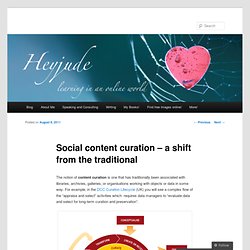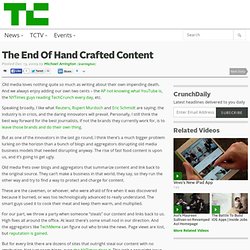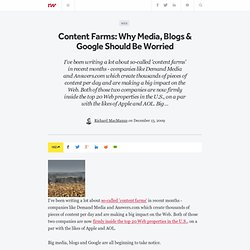

Content Curation & Fair Use: 5 Rules to being an Ethical Content Curator. * Update: I have a much lengthier updated post that incorporates the material below: Content Curation: Copyright, Ethics, & Fair Use Recently, Kimberley Isbell of the Nieman Journalism Lab cited a Harvard Law report and published an extensive post on news aggregation and legal considerations.

From a curation perspective, the whole article is interesting, but what was the most surprising was that her recommendations for being an ethical content aggregator, were the same as being an effective content curator. The five recommendations are below. You can read the full article for the legal justifications for abiding by these practices.
However, I have provided some reason on why you would want to follow these guidelines from a content marketing perspective: 1. Marketing reason: The more you link to third parties, the more likely they are to link back to you – which ultimately improves your SEO. 2. 3. 4. Social content curation – a shift from the traditional. The notion of content curation is one that has traditionally been associated with libraries, archivies, galleries, or organisations working with objects or data in some way.

For example, in the DCC Curation Lifecycle (UK) you will see a complex flow of the “appraise and select” activities which requires data managers to “evaluate data and select for long-term curation and preservation”. So ‘selection’ or ‘acquisition’ is then closely linked to a repository or institutional policy on collection development. Now the extraordinary thing is that the term ‘curation’ has become one of the latest buzz-words in the social online sphere, which has been transformed into an activity that is both about marketing and about organisation of the vast information flow that is delivered via social media.
Social networking has definitely provided us with main channels for information flow. It comes down to organizing your sources, knowing which of them are trust worthy, and seeing patterns. New content and better access = content curation. It seems that the latest buzzword around the web is ‘content curation’.

There are literally millions of posts about this already, and new tools and new marketing strategies are being deployed to meet this new demand. Don't just move the information, curate it! — The People Equation. I recently attended a local art competition called ArtPrize.

The free event is billed as “radically open”, meaning any artist, venue and citizen can participate. The openness creates a pretty random experience: grab a map, walk around downtown and check out the art. One of my favorite venues featured 25 artists in the Women’s City Club. Why was it my favorite? It wasn’t that I loved all the artwork. The positive vibe was due to something else. Collecting related content isn't curation. The End Of Hand Crafted Content. Old media loves nothing quite so much as writing about their own impending death.

And we always enjoy adding our own two cents – the AP not knowing what YouTube is, the NYTimes guys reading TechCrunch every day, etc. Speaking broadly, I like what Reuters, Rupert Murdoch and Eric Schmidt are saying: the industry is in crisis, and the daring innovators will prevail. Personally, I still think the best way forward for the best journalists, if not the brands they currently work for, is to leave those brands and do their own thing. But as one of the innovators in the last go round, I think there’s a much bigger problem lurking on the horizon than a bunch of blogs and aggregators disrupting old media business models that needed disrupting anyway.
The rise of fast food content is upon us, and it’s going to get ugly. Old media frets over blogs and aggregators that summarize content and link back to the original source. But even then, companies like ours can find a way to compete. Content farms. I've been writing a lot about so-called 'content farms' in recent months - companies like Demand Media and Answers.com which create thousands of pieces of content per day and are making a big impact on the Web.

Both of those two companies are now firmly inside the top 20 Web properties in the U.S., on a par with the likes of Apple and AOL. Big media, blogs and Google are all beginning to take notice. Chris Ahearn, President of Media at Thomson Reuters, recently published an article on how journalism can survive in the Internet age. TechCrunch founder Michael Arrington also riffs on this theme, mentioning AOL's "Toyota Strategy of building thousand of niche content sites via the work of cast-offs from old media" and quoting a Wired piece on Demand Media from October. I started my analysis of Demand Media in this August post. In November I explored more about how Demand Media produces 4,000 pieces of content a day, based on an interview I did with the founders in September. The Shared Web: Making curators of us all. Editors as Curators: What's Taking So Long? These are tough times for editors.

Senior editors are being forced to make deep, painful cuts in their newsrooms. Assignment editors are being phased out at some papers, seen as extraneous layers in the production process. Copy editors are seeing their jobs consolidated or even outsourced. And many reporters, by their nature, never had much use for editors of any stripe to begin with. But the news judgment skills of editors should be more valuable now than they've ever been before to newspapers and other news organizations.